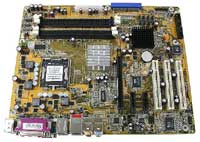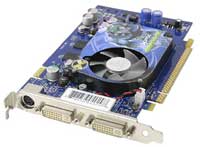Gaming Buyer's Guide - November 2004
by Jarred Walton on November 21, 2004 5:54 PM EST- Posted in
- Guides
Intel Budget Gaming System
At the lowest end of the spectrum, AMD doesn't have quite as much of an advantage in performance over Intel, since the CPU is less of a bottleneck, and there is one item that Intel can offer which AMD cannot (yet): PCI Express. Suffice it to say that especially for die-hard Intel fans, they are not a terrible choice, although they do cost slightly more. Here is our best attempt at matching the Budget AMD system's price and performance.| Budget Intel Pentium 4 System | ||
| Hardware | Recommended Component | Price |
| Processor | Pentium 4 520 2.8 GHz 1MB Cache | 158 |
| Motherboard | DFI 915P-TAG i915P | 118 |
| Memory | 1x512MB Mushkin Basic 2.5-4-4 | 75 |
| Video Card | XFX GeFORCE 6600GT 128 MB | 178 |
| Hard Drive | Seagate Barracuda 80GB EIDE model 7200.7 | 59 |
| Optical Drive | NEC DVD+/-RW Drive Model 3500A | 72 |
| Case and Power Supply | Athenatech A602 Black/Silver with 350W PSU | 62 |
| Display | Samsung 793DF 17 Black/Silver CRT (1280x1024@75 Hz) | 139 |
| Speakers | Logitech Z-640 5.1 | 52 |
| Keyboard and Mouse | Logitech Optical Desktop Combo | 26 |
| Bottom Line | 939 | |
 Click to enlarge. |
 Click to enlarge. |
Another drawback is that dual-channel RAM helps the Pentium 4 more than it does the Athlon 64, so using only one DIMM is going to cut into that performance boost a bit. If you plan on adding 512MB of RAM in the near future, that's not too big of a problem. Otherwise - and we hesitate to say this as they may not be of much use in future systems - using two 256 MB DIMMs will cost about the same as a single 512 MB DIMM. The extra $70 or so spent on an Intel system could be put into other items like a better graphics card or a faster CPU, and AMD also has the 64-bit factor to consider. This is why we still give AMD our primary recommendation, but it really is a close match-up in this price bracket.
Besides shipping PCI Express support, Intel also has their HyperThreading feature, which can help in certain multi-tasking applications. We have not yet seen any performance benefit to HyperThreading in the gaming realm - quite the reverse, in fact, as most games run a few percent slower with HTT enabled - but that could change in the future. With both AMD and Intel shifting away from increasing clock speeds to multi-core designs, it would make sense that games at some point will need to shift to a multi-threaded programming environment in order to extract the most performance from the processor. HTT ends up being nothing that we are overly concerned with as far as games go, but it's still there and it could come into play in the next year or two.
If you feel that our budget recommendations are almost impractical, just take that as an indication of the difficulty of selecting parts for this price segment. These three platforms are all very capable, however, and none of them is truly a bad choice. If you're the type of person who upgrades parts frequently - i.e. more than twice a year - over the life of your system, the socket 939 and socket 775 platforms will be a better choice. From a pure price standpoint, socket 754 still wins out.










70 Comments
View All Comments
blckgrffn - Tuesday, November 23, 2004 - link
At Newegg, sorry.blckgrffn - Tuesday, November 23, 2004 - link
$35 shipped, 420W thermaltake silent purepower w/18A on the +12 rail - can't beat that. No sense in not upgrading to it in my opinion. Also has two SATA power connectors. It may not be the best, but it is a good brand for low dough, and it regularly retails for under $40. I see no reason not to reccommend it as an alternative, at least.Just my $.02 :-)
JarredWalton - Tuesday, November 23, 2004 - link
I was gone for the weekend due to a personal matter, which is why I have not commented much yet. Basically, the budget segment is extremely difficult to target without cutting some corners. The PSU is definitely one of the corners that was cut. I will certainly agree that a cheap PSU is not the best option, but for a moderate system it should do okay. We do not build and test every one of the systems we recommend here, although we do test the majority of the parts. For the budget system, even a moderate PSU is going to add $50 to the price. It might be worth it, but I would go with the generic for a little while if you're on a tight budget.The mid-range use of the SLK3700-BQE case and PSU is a different story. The 350W Antec PSUs are actually quite good and when paired with that setup I have yet to experience any issues. If you're going to add in a second hard drive and optical drive and try overclocking, it could present a problem, but for the stock recommendation it will work.
I thought I made the PSU situation clear in the article, but looking back I guess it was sort of relegated to a few comments made in the high-end and component summary pages. A good PSU is never a bad investment. Trying to convince someone to spend $75 on a name-brand 400W+ PSU instead of upgrading some other component is difficult to do, unfortunately. I'll make sure I don't overlook this in the future - particularly on the mid-range systems.
Gorion: The component summaries were arranged in order of price, with my suggestion of what budget each component falls into. You'll note that many of the parts do not match up directly with the system we put them in, for example we had to use a "mid-range" priced motherboard for the Intel budget setup. The graphics cards in particular are where we "overspent" - which makes sense for gaming.
You're right on the mouse: the MX510 is the wired version. My bad. Basically, get what mouse you like. I have tried the MX510 before, and while not bad, it's a personal taste. I like the 4th and 5th buttons on opposite sides like the "cheap" MS mice. For precision, Logitech may be better, but I am definitely not hardcore enough to be able to tell the difference between mouse precision on these models. :)
Glassmaster - Tuesday, November 23, 2004 - link
#45: I'm not suggesting that a PSU recommendation should account for overclocking, however, on AMD's offical forums, where I help with Athlon 64 troubleshooting, insufficant PSUs are the most common problem. People are having problems with their PSUs handling stock specifications when they do something demanding, like play a modern game. This is a gaming guide after all...That's why I ask if you build and stress test these systems with the latest games before making a recommendation. If you do, and you find that a particular cheap generic PSU (with less than the consensus recommendation of 18-20A on the 12V rail) works well, that would be good to know. However that has not been my experience.
I wouldn't bother to post at all if I didn't respect this site a lot and enjoy reading it--I would just stop visiting.
Glassmaster.
Wesley Fink - Tuesday, November 23, 2004 - link
RE: The Epox budget board. Jarred had originally selected the Epox budget nf3-250Gb for his budget AMD gamer, but I shared many of the emails I had received re: memory problems with that board. Nothing major, but memory compatibility issues and 4-dimm 333 downclocks not seen with the Chaintech board. While we all agree the Epox has a bit better feature set the Chaintech is known to be rock solid and friendly to just about any memory you feed it. That is the reason for the Chaintech choice for Budget. If you know your memory choice works well with the Epox then by all means choose that board.As an overclocker I have learned the hard way how very important the PS is for Athlon 64 and Socket T Intel. However, most gamers are NOT overclockers - they may overclock the video card but they rarely do much with system overclocking. Given that, Jarred's PS choices make more sense, though I do agree budget Power Supplies are the weakest links in most systems. I'm sure those gamers that "system-overclock" will throw some rocks here, and there are exceptions to every generalization.
thegreatbernie - Tuesday, November 23, 2004 - link
I haven't been able to find the Albatron GeFORCE 6800 GT 256MB GDDR3 for $374. Newegg has it for $455.Gioron - Tuesday, November 23, 2004 - link
Jarred:Two nit-picks, the first being the motherboard chart on the component summary page. The third motherboard down threw me for a second, until I realized it was the third budget motherboard, not the mid-range motherboard it was listed as.
Second, the MX510 is a wired mouse, not wireless. The wireless Ligitech mice are the MX700 and MX1000, the MX510, MX500, and MX300 are all wired mice. I'm guessing you're thinking about the MX700 mouse, which I admit is a bit of an acquired taste, but if you haven't used one before, I'd highly recommend trying out the MX510 before dismissing it.
Disclaimer: I personally use an MX1000 as a replacement to my MX700, but I freely admit its not for everyone.
SDA - Tuesday, November 23, 2004 - link
Damn, I hate to double-post, but I just found something interesting while poking around:http://forums.anandtech.com/messageview.aspx?catid...
Might be worth a read for those of you that don't understand what I have against low-quality power supplies.
SDA - Tuesday, November 23, 2004 - link
#38, no, I guess it doesn't :( No offense to AT, but I doubt they bother-- after all, the PSU is such a trivial piece of hardware, isn't it? Sigh.. anyway, correct me if I'm wrong, but it'd seem that the PSU in the Athenatech case is an L&C unit. Deer/L&C units aren't exactly.. known for their quality.Now, I don't want to seem like I'm sniping, because overall I think this is a pretty good guide. Everyone's going to have their own suggestions and their own favorite parts. A quality PSU isn't something that one would pick just because of their preference, though, it's something one would pick because of their sanity. I've lost count of the number of malfunctioning systems I've seen fixed with replacement PSUs, not to mention how many cheapo power supplies I've seen fail in amusing ways before their time.. picking a cheap PSU to power a solid system is a newbie mistake, it's a shame to see a pro make it.
bofkentucky - Tuesday, November 23, 2004 - link
#39Except it is overpriced, uses an overpriced processor, uses slow ram and is feature limited (No on board SATA). Dothan has potential, but wait until the 915 based dothan boards hit the streets, then you will see a real performance option.